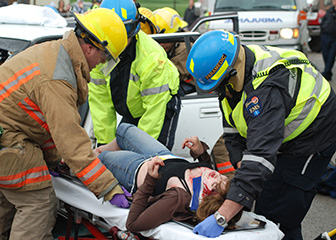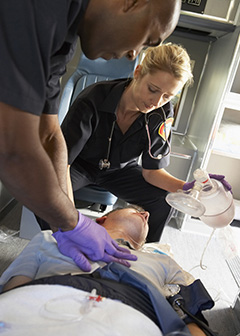
EMTs and paramedics need to be physically fit as their job requires a considerable amount of bending, lifting, and kneeling.
All emergency medical technicians (EMTs) and paramedics must complete a formal training program. All states require EMTs and paramedics to be licensed; requirements vary by state.
Education and Training
Both a high school diploma or equivalent and cardiopulmonary resuscitation (CPR) certification are prerequisites for most formal education and training programs. High school students interested in entering these occupations should take courses in anatomy and physiology. Formal training is offered by technical institutes, community colleges, and facilities that specialize in emergency care training.
At the EMT-Basic level, training includes instruction in assessing patients' conditions, dealing with trauma and cardiac emergencies, clearing obstructed airways, using field equipment, and handling emergencies. Formal courses include about 100 hours of specialized training. Some training may be required in a hospital or ambulance setting.
The EMT-Intermediate 1985 or EMT-Intermediate 1999 level, also known as the Advanced EMT level, typically requires 1,000 hours of training based on the scope of practice. At this level, people must complete the training required at the EMT level, as well as more advanced training, such as training in the use of complex airway devices, intravenous fluids, and some medications.
Paramedics have the most advanced level of training. They must complete EMT-level and Advanced EMT training, as well as training in advanced medical skills. Community colleges and technical schools may offer this training, in which graduates may receive an associate's degree. Paramedic programs require about 1,300 hours of training and may take up to 2 years. Their broader scope of practice may include stitching wounds or administering IV medications.
Separate training and licensure is required to drive an ambulance. Although some emergency medical services hire separate drivers, most EMTs and paramedics take a course requiring about 8 hours of training before they can drive an ambulance.
Licenses and Certification
The National Registry of Emergency Medical Technicians (NREMT) certifies EMTs and paramedics. All levels of NREMT certification require completing a certified training or education program and passing the national exam. The national exam has both a written part and a practical part.
All states require EMTs and paramedics to be licensed; requirements vary by state. In most states, an individual who has NREMT certification qualifies for licensure; in some, passing an equivalent state exam is required. Typically to apply for a license, an applicant must be over the age of 18. Many states require background checks and may decide not to give a license to an applicant who has a criminal history.
Important Qualities
Compassion. EMTs and paramedics must provide emotional support to patients in an emergency, especially patients who are in life-threatening situations or extreme mental distress.
Interpersonal skills. EMTs and paramedics almost always work on teams and must be able to coordinate their activities closely with others in stressful situations.
Listening skills. EMTs and paramedics need to listen to patients to determine the extent of their injuries or illnesses.
Physical strength. EMTs and paramedics need to be physically fit. Their job requires a lot of bending, lifting, and kneeling.
Problem-solving skills. EMTs and paramedics need strong problem-solving skills. They must evaluate patients’ symptoms and administer the appropriate treatments.
Speaking skills. EMTs and paramedics need to be able to comfort and explain procedures to the patient, give orders, and relay information to others.









